
Morchella, the true morels, is a genus of edible sac fungi closely related to anatomically simpler cup fungi in the order Pezizales. These distinctive fungi have a honeycomb appearance due to the network of ridges with pits composing their caps. Morels are prized by gourmet cooks, particularly in Catalan and French cuisine. Due to difficulties in cultivation, commercial harvesting of wild morels has become a multimillion-dollar industry in the temperate Northern Hemisphere, in particular North America, Turkey, China, the Himalayas, India, and Pakistan where these highly prized fungi are found in abundance.

Helvella crispa, also known as the white saddle, elfin saddle or common helvel, is an ascomycete fungus of the family Helvellaceae. The mushroom is readily identified by its irregularly shaped whitish cap, fluted stem, and fuzzy undersurfaces. It is found in eastern North America and in Europe, near deciduous trees in summer and autumn.
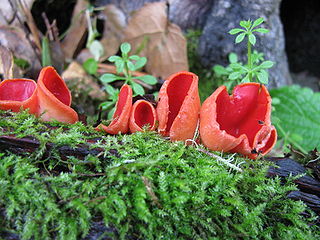
Sarcoscypha coccinea, commonly known as the scarlet elf cup, scarlet elf cap, or the scarlet cup, is a species of fungus in the family Sarcoscyphaceae of the order Pezizales. The fungus, widely distributed in the Northern Hemisphere, has been found in Africa, Asia, Europe, North and South America, and Australia. The type species of the genus Sarcoscypha, S. coccinea has been known by many names since its first appearance in the scientific literature in 1772. Phylogenetic analysis shows the species to be most closely related to other Sarcoscypha species that contain numerous small oil droplets in their spores, such as the North Atlantic island species S. macaronesica. Due to similar physical appearances and sometimes overlapping distributions, S. coccinea has often been confused with S. occidentalis, S. austriaca, and S. dudleyi.

Gyromitra infula, commonly known as the hooded false morel or the elfin saddle, is a fungus in the family Helvellaceae. The dark reddish-brown caps of the fruit bodies develop a characteristic saddle-shape in maturity, and the ends of both saddle lobes are drawn out to sharp tips that project above the level of the fruit body. The stipe is white or flushed pale brown, smooth on the outside, but hollow with some chambers inside. It is found in the Northern Hemisphere, usually in the late summer and autumn, growing on rotting wood or on hard packed ground. G. infula is considered inedible as it contains the toxic compound gyromitrin which, when metabolized by the body, is converted into monomethylhydrazine, a component of some rocket fuels. The toxin may be removed by thorough cooking. Gyromitra fungi are included in the informal category "false morels".

Lichenomphalia is both a basidiolichen and an agaric genus. Most of the species have inconspicuous lichenized thalli that consist of scattered, small, loose, nearly microscopic green balls or foliose small flakes containing single-celled green algae in the genus Coccomyxa, all interconnected by a loose network of hyphae. The agaric fruit bodies themselves are nonlichenized and resemble other types of omphalinoid mushrooms. These agarics lack clamp connections and do not form hymenial cystidia. The basidiospores are hyaline, smooth, thin-walled, and nonamyloid. Most of the species were originally classified in the genera Omphalina or Gerronema. Historically the species were classified with those other genera in the family, the Tricholomataceae together with the nonlichenized species. Lichenomphalia species can be grouped into brightly colored taxa, with vivid yellow and orange colors, versus the grey brown group, depending upon the microscopic pigmentation deposits. Molecular research comparing DNA sequences now place Lichenomphalia close to the redefined genus Arrhenia, which together with several other genera not traditionally considered to be related, fall within the newly redefined Hygrophoraceae.

Melanoleuca is a poorly known genus of saprotrophic mushrooms traditionally classified in the family Tricholomataceae. Most are small to medium sized, white, brown, ocher or gray with a cylindrical to subcylindrical stipe and white to pale yellowish gills. The basidiospores are ellipsoid and ornamented with amyloid warts. Melanoleuca is considered a difficult group to study due to their macroscopic similarities among species and the need of a thorough microscopic analysis to separate species. DNA studies have determined that this genus is closely related to Amanita and Pluteus and that it does not belong to the family Tricholomataceae.

The Helvellaceae are a family of ascomycete fungi, the best-known members of which are the elfin saddles of the genus Helvella. Originally erected by Elias Magnus Fries in 1823 as Elvellacei, it contained many genera. Several of these, such as Gyromitra and Discina, have been found to be more distantly related in a molecular study of ribosomal DNA by mycologist Kerry O'Donnell in 1997, leaving a much smaller core clade now redefined as Helvellaceae. Instead, this narrowly defined group is most closely related to the true truffles of the Tuberaceae. Although the Dictionary of the Fungi considered the Helvellaceae to contain six genera and 63 species, genetic analysis has shown that Leucangium, previously classified in this family, is more closely related to the Morchellaceae.
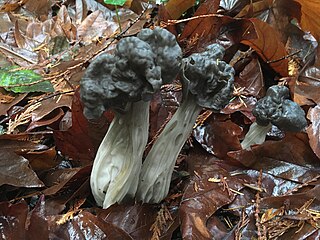
Helvella lacunosa, known as the slate grey saddle or fluted black elfin saddle in North America, simply as the elfin saddle in Britain, is an ascomycete fungus of the family Helvellaceae. It is one of the most common species in the genus Helvella. The mushroom is readily identified by its irregularly shaped grey cap, fluted stem, and fuzzy undersurfaces. It is usually found in Eastern North America and in Europe, near deciduous and coniferous trees in summer and autumn.

Bovista is a genus of fungi commonly known as the true puffballs. It was formerly classified within the now-obsolete order Lycoperdales, which, following a restructuring of fungal taxonomy brought about by molecular phylogeny, has been split; the species of Bovista are now placed in the family Agaricaceae of the order Agaricales. Bovista species have a collectively widespread distribution, and are found largely in temperate regions of the world. Various species have historically been used in homeopathic preparations.

Clathrus ruber is a species of fungus in the family Phallaceae, and the type species of the genus Clathrus. It is commonly known as the latticed stinkhorn, the basket stinkhorn, or the red cage, alluding to the striking fruit bodies that are shaped somewhat like a round or oval hollow sphere with interlaced or latticed branches. The fungus is saprobic, feeding off decaying woody plant material, and is often found alone or in groups in leaf litter on garden soil, grassy places, or on woodchip garden mulches. Although considered primarily a European species, C. ruber has been introduced to other areas, and now has a wide distribution that includes all continents except Antarctica. The species was illustrated in the scientific literature during the 16th century, but was not officially described until 1729.

Helvella acetabulum is a species of fungus in the family Helvellaceae, order Pezizales. This relatively large cup-shaped fungus is characterized by a tan fruit body with prominent branching ribs resembling a cabbage leaf; for this reason it is commonly known as the cabbage leaf Helvella. Other colloquial names include the vinegar cup and the brown ribbed elfin cup. The fruit bodies reaches dimensions of 8 cm (3.1 in) by 4 cm (1.6 in) tall. It is found in Asia, Europe, and North America, where it grows in sandy soils, under both coniferous and deciduous trees.
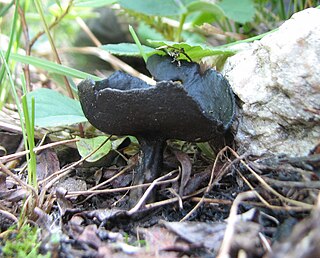
Helvella corium is a species of fungus in the family Helvellaceae of the order Pezizales. This inedible cup-shaped fungus is black, and grows on the ground often near willows in deciduous or mixed forests. Although it has a fairly wide distribution, it is uncommon.
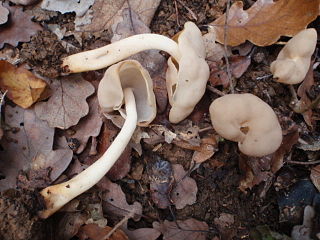
Helvella elastica, commonly known as the flexible Helvella, or the elastic saddle, is a species of fungus in the family Helvellaceae of the order Pezizales. It is found in Asia, Europe, and North America. It has a roughly saddle-shaped yellow-brown cap atop a whitish stipe, and grows on soil in woods. Another colloquial name is the brown elfin saddle.

Dissingia leucomelaena, commonly known as the white-footed elf cup, is a species of fungus in the family Helvellaceae of the order Pezizales. As its common name implies, it is characterized by the white coloring of its stem.

Helvella solitaria is a species of fungus in the family Helvellaceae. Originally described as Peziza solitaria by Petter Karsten in 1869, he transferred it to the genus Helvella in 1871. The fungus has a boreal and temperate distribution.

Amanita aestivalis, commonly known as the white American star-footed amanita, is a species of fungus in the mushroom family Amanitaceae. The fungus is distributed in the eastern United States, south to Florida, and reaches north into the southeastern provinces of Canada. The cap of the fruit body is medium-sized, 5 to 8.5 cm in diameter and white. It sits atop a stem that is 8.5 to 16 cm long and has a rounded bulb at its base. The entire fruit body will slowly stain a reddish-brown color in response to bruising or aging. It remains unknown whether Amanita aestivalis is a distinct species from A. brunnescens, another similar Amanita with a comparable distribution. There are several other white-bodied amanitas with which A. aestivalis may be confused, including A. virosa, A. phalloides, and A. bisporigera.
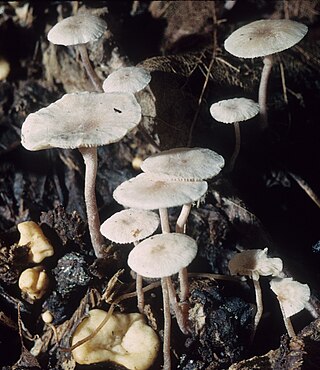
Collybia cookei is a species of fungus in the family Tricholomataceae, and one of three species in the genus Collybia. It is known from Europe, Asia, and North America. The fungus produces fruit bodies that usually grow on the decomposing remains of other mushrooms, like Meripilus giganteus, Inonotus hispidus, or species of Russula; occasionally fruit bodies are found on rich humus or well-decayed wood. The fungus produces small white mushrooms with caps up to 9 mm (0.35 in) in diameter, supported by thin stems that originate from a yellowish-brown sclerotium. The mushroom is difficult to distinguish from the other two species of Collybia unless an effort is made to examine the sclerotia, which is usually buried in the substrate. The edibility of the mushroom has not been determined.

Helvella vespertina is a species of fungus in the family Helvellaceae. It is found in Western North America under conifers. Some specimens have a white moldy appearance, having been colonised by the parasitic Ascomycete fungus Hypomyces cervinigenus.

Helvella dryophila is a species of fungus in the family Helvellaceae. It is found in western North America, where it associates with oak.

Hypomyces cervinigenus is a parasitic ascomycete fungus that grows on elfin saddle (Helvella) mushrooms in Europe and North America. It was described as new to science in 1971 by Clark Rogerson and Horace Simms. The type collection was made in Pierce County, Washington, where the fungus was found growing on the stipe and cap of what they identified as a fruit body of Helvella lacunosa; later molecular work demonstrated that the European H. lacunosa is not found in North America, and that the North American versions are in fact two similar species, H. vespertina and H. dryophila. H. cervinigenus has perithecia that are white to pale buff with a waxy texture. The ascospores are two-celled, smooth-walled, and measure less than 25 µm long. The anamorph form of the fungus is known as Mycogone cervina.























